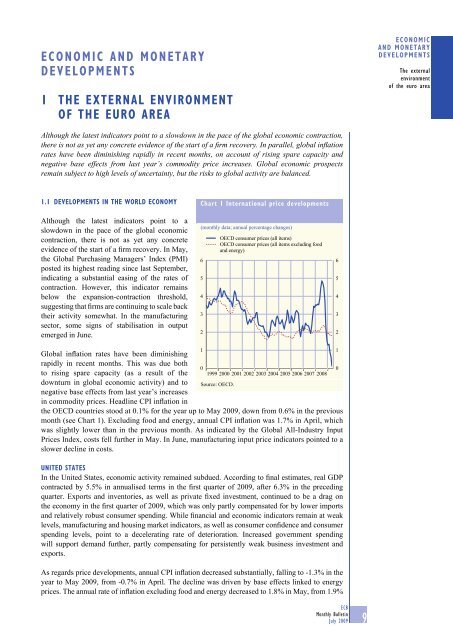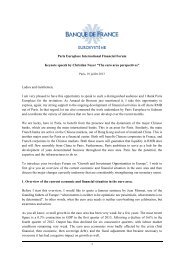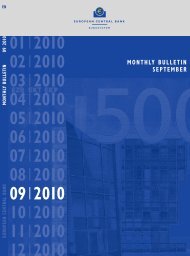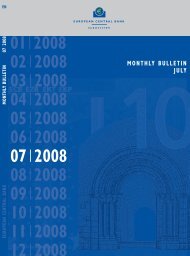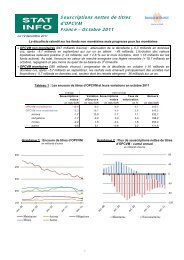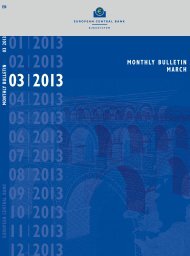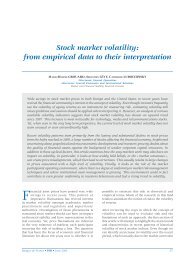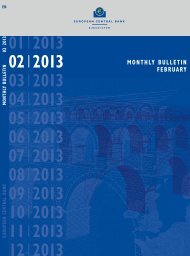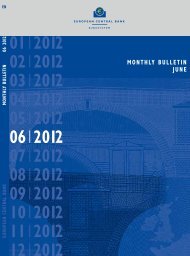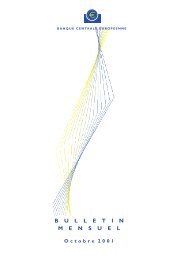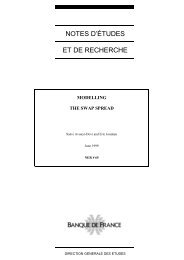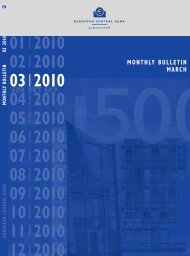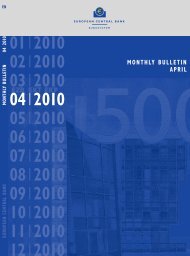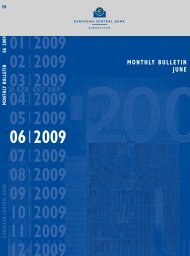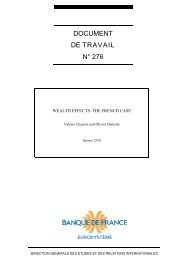Monthly Bulletin July 2009 - Banque de France
Monthly Bulletin July 2009 - Banque de France
Monthly Bulletin July 2009 - Banque de France
Create successful ePaper yourself
Turn your PDF publications into a flip-book with our unique Google optimized e-Paper software.
ECONOMIC AND MONETARY<br />
DEVELOPMENTS<br />
1 THE EXTERNAL ENVIRONMENT<br />
OF THE EURO AREA<br />
ECONOMIC<br />
AND MONETARY<br />
DEVELOPMENTS<br />
The external<br />
environment<br />
of the euro area<br />
Although the latest indicators point to a slowdown in the pace of the global economic contraction,<br />
there is not as yet any concrete evi<strong>de</strong>nce of the start of a fi rm recovery. In parallel, global infl ation<br />
rates have been diminishing rapidly in recent months, on account of rising spare capacity and<br />
negative base effects from last year’s commodity price increases. Global economic prospects<br />
remain subject to high levels of uncertainty, but the risks to global activity are balanced.<br />
1.1 DEVELOPMENTS IN THE WORLD ECONOMY<br />
Although the latest indicators point to a<br />
slowdown in the pace of the global economic<br />
contraction, there is not as yet any concrete<br />
evi<strong>de</strong>nce of the start of a firm recovery. In May,<br />
the Global Purchasing Managers’ In<strong>de</strong>x (PMI)<br />
posted its highest reading since last September,<br />
indicating a substantial easing of the rates of<br />
contraction. However, this indicator remains<br />
below the expansion-contraction threshold,<br />
suggesting that firms are continuing to scale back<br />
their activity somewhat. In the manufacturing<br />
sector, some signs of stabilisation in output<br />
emerged in June.<br />
Chart 1 International price <strong>de</strong>velopments<br />
(monthly data; annual percentage changes)<br />
6<br />
5<br />
4<br />
3<br />
2<br />
OECD consumer prices (all items)<br />
OECD consumer prices (all items excluding food<br />
and energy)<br />
6<br />
5<br />
4<br />
3<br />
2<br />
Global inflation rates have been diminishing<br />
rapidly in recent months. This was due both<br />
to rising spare capacity (as a result of the<br />
downturn in global economic activity) and to<br />
negative base effects from last year’s increases<br />
in commodity prices. Headline CPI inflation in<br />
the OECD countries stood at 0.1% for the year up to May <strong>2009</strong>, down from 0.6% in the previous<br />
month (see Chart 1). Excluding food and energy, annual CPI inflation was 1.7% in April, which<br />
was slightly lower than in the previous month. As indicated by the Global All-Industry Input<br />
Prices In<strong>de</strong>x, costs fell further in May. In June, manufacturing input price indicators pointed to a<br />
slower <strong>de</strong>cline in costs.<br />
UNITED STATES<br />
In the United States, economic activity remained subdued. According to final estimates, real GDP<br />
contracted by 5.5% in annualised terms in the first quarter of <strong>2009</strong>, after 6.3% in the preceding<br />
quarter. Exports and inventories, as well as private fixed investment, continued to be a drag on<br />
the economy in the first quarter of <strong>2009</strong>, which was only partly compensated for by lower imports<br />
and relatively robust consumer spending. While financial and economic indicators remain at weak<br />
levels, manufacturing and housing market indicators, as well as consumer confi<strong>de</strong>nce and consumer<br />
spending levels, point to a <strong>de</strong>celerating rate of <strong>de</strong>terioration. Increased government spending<br />
will support <strong>de</strong>mand further, partly compensating for persistently weak business investment and<br />
exports.<br />
As regards price <strong>de</strong>velopments, annual CPI inflation <strong>de</strong>creased substantially, falling to -1.3% in the<br />
year to May <strong>2009</strong>, from -0.7% in April. The <strong>de</strong>cline was driven by base effects linked to energy<br />
prices. The annual rate of inflation excluding food and energy <strong>de</strong>creased to 1.8% in May, from 1.9%<br />
1<br />
0<br />
1999 2000 2001 2002 2003 2004 2005 2006 2007<br />
Source: OECD.<br />
2008<br />
1<br />
0<br />
ECB<br />
<strong>Monthly</strong> <strong>Bulletin</strong><br />
<strong>July</strong> <strong>2009</strong><br />
9


